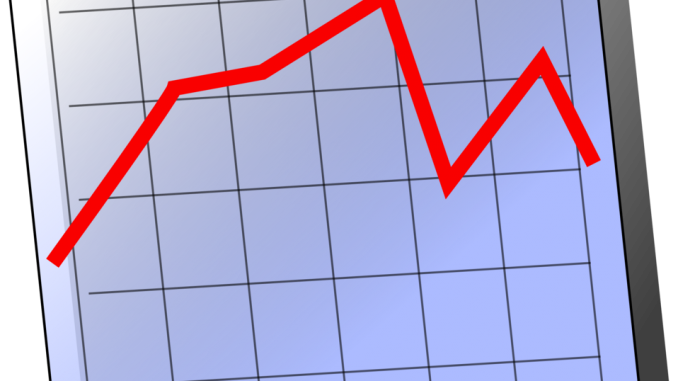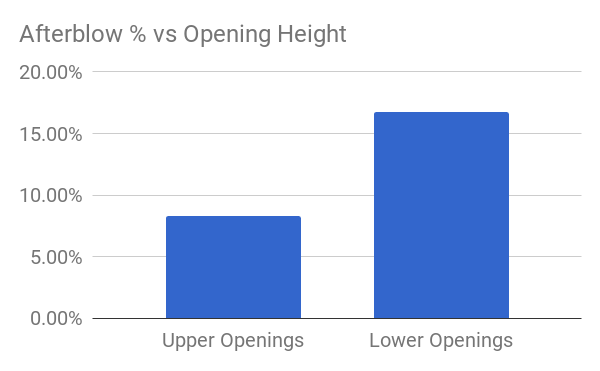
I recently came across a statement to the effect of “Having a 4 point target with only 1 point deducted for afterblow is too little. No matter what you still get 3 points and it doesn’t encourage the fighter to protect themselves.” Two things came to mind:
- I have an opinion on this. Unfortunately this does little to separate me from every other HEMA practitioner with a keyboard.
- More importantly I have actual data which I can use to get a clearer understanding of the situation.
Thus I fired up the ol’ database and had a look.
*note RAS = Relative Afterblow Strength. (ie 4 -1 is a relatively low strength, 4 -2 is higher, and 1 -1 would be even higher)
Afterblows and Target Points
Based on 6,774 scoring exchanges we see the following data:

The first thing that stands out is that the % of times that a 4 point shot results in an afterblow is really low! But other than that the pattern of more afterblows for more points seems to hold. Clearly based on this data clearly we should make all targets worth 4 points, with a 1 point afterblow, and we will have the cleanest possible tournaments. 😉
But seriously, what does this tell us?
The one thing that this graph doesn’t capture is target location. For most, but not all, of the tournaments this data was collected on the point values were allocated:
1 Point – Arm
2 Points – Legs
3 Points – Body
4 Points – Head
Normally I would stick in a re-labeled graph in with the points replaced by targets. But the rules had enough oscillation that I can’t really be that confident. But there is one very noticeable general trend.
Afterblows and Opening Height

Clearly attacking the lower openings is much less safe. This shouldn’t be news, the data just supports what the sources say.
Conclusions Based on Data
Based on this data it is obviously not possible to construct a Grand Unified Theory of Afterblows. However it does clearly show a few things:
- Having a 4 point target with only a 1 point afterblow does not automatically make people attack it more unsafely than with a higher relative afterblow.
- Attacking lower openings leads to more afterblows than attacking upper openings
Conclusions Based on Opinion
Now what my take on what the data shows.
It is my opinion that the RAS influences the behavior of the ‘defender’ more than the ‘attacker’. (I use quotes, because we all know how ambiguous the concept can be in the middle of the exchange. For the purpose I will use the defender to mean the person who is in danger of being hit by an attack before any call has been made by a judge.)
With a lower RAS the defender is less able to mitigate the effect of being hit in a high value target, leading to them protecting it with a little more ‘desperation’. This makes them behave in ways which prioritize not getting hit, rather than being able to respond quickly with counterattacks & afterblows.
Unfortunately using this data we can’t really separate the effects of targets vs points on afterblow percentages, but it’s a little food for thought if you think that decreasing the strength of an afterblow automatically means that people attack less safely!
Edit: I did a follow up investigation where I looked at the same statistics, but separated by participant skill. How Much Does Participant Skill Affect Overall Behavior
Full Data
For those of you that care:
| Target Points | Afterblow % | Afterblows | Clean | Total |
| 1 | 10.6 | 248 | 2089 | 2337 |
| 2 | 14.5 | 152 | 895 | 1047 |
| 3 | 18.3 | 265 | 1182 | 1447 |
| 4 | 5.6 | 109 | 1834 | 1943 |
If you are nerdy enough to want to pore through this kind of thing, drop me a line! I’m always looking for analytically minded people to collaborate with, and expand the size of data sets the community has access to.


It’s less explicit here than in the participant skill affecting overall behavior, but is this data set limited to the longsword tournaments as I’m assuming it is?
That is correct.
The other tournaments either:
– Have less data
– Have ‘flatter’ scoring which makes it harder to sort out targets from points.
Singlestick is the only one which would be close, but I would say that the number of participants from a single school (BnI) would be enough that school specific training methodologies would probably play a significant part in the data that is seen.